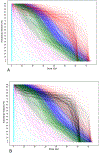Cluster-Based Toxicity Estimation of Osteoradionecrosis Via Unsupervised Machine Learning: Moving Beyond Single Dose-Parameter Normal Tissue Complication Probability by Using Whole Dose-Volume Histograms for Cohort Risk Stratification
- PMID: 38462018
- PMCID: PMC11262961
- DOI: 10.1016/j.ijrobp.2024.02.021
Cluster-Based Toxicity Estimation of Osteoradionecrosis Via Unsupervised Machine Learning: Moving Beyond Single Dose-Parameter Normal Tissue Complication Probability by Using Whole Dose-Volume Histograms for Cohort Risk Stratification
Abstract
Purpose: Given the limitations of extant models for normal tissue complication probability estimation for osteoradionecrosis (ORN) of the mandible, the purpose of this study was to enrich statistical inference by exploiting structural properties of data and provide a clinically reliable model for ORN risk evaluation through an unsupervised-learning analysis that incorporates the whole radiation dose distribution on the mandible.
Methods and materials: The analysis was conducted on retrospective data of 1259 patients with head and neck cancer treated at The University of Texas MD Anderson Cancer Center between 2005 and 2015. During a minimum 12-month posttherapy follow-up period, 173 patients in this cohort (13.7%) developed ORN (grades I to IV). The (structural) clusters of mandibular dose-volume histograms (DVHs) for these patients were identified using the K-means clustering method. A soft-margin support vector machine was used to determine the cluster borders and partition the dose-volume space. The risk of ORN for each dose-volume region was calculated based on incidence rates and other clinical risk factors.
Results: The K-means clustering method identified 6 clusters among the DVHs. Based on the first 5 clusters, the dose-volume space was partitioned by the soft-margin support vector machine into distinct regions with different risk indices. The sixth cluster entirely overlapped with the others; the region of this cluster was determined by its envelopes. For each region, the ORN incidence rate per preradiation dental extraction status (a statistically significant, nondose related risk factor for ORN) was reported as the corresponding risk index.
Conclusions: This study presents an unsupervised-learning analysis of a large-scale data set to evaluate the risk of mandibular ORN among patients with head and neck cancer. The results provide a visual risk-assessment tool for ORN (based on the whole DVH and preradiation dental extraction status) as well as a range of constraints for dose optimization under different risk levels.
Copyright © 2024 The Author(s). Published by Elsevier Inc. All rights reserved.
Figures





Update of
-
Cluster-Based Toxicity Estimation of Osteoradionecrosis via Unsupervised Machine Learning: Moving Beyond Single Dose-Parameter Normal Tissue Complication Probability by Using Whole Dose-Volume Histograms for Cohort Risk Stratification.medRxiv [Preprint]. 2023 Mar 29:2023.03.24.23287710. doi: 10.1101/2023.03.24.23287710. medRxiv. 2023. Update in: Int J Radiat Oncol Biol Phys. 2024 Aug 1;119(5):1569-1578. doi: 10.1016/j.ijrobp.2024.02.021. PMID: 37034700 Free PMC article. Updated. Preprint.
References
-
- Jacobson AS, Buchbinder D, Hu K, Urken ML. Paradigm shifts in the management of osteoradionecrosis of the mandible. Oral Oncology 2010;46:795–801. - PubMed
-
- Lee IJ, Koom WS, Lee CG, et al. Risk factors and dose-effect relationship for mandibular osteoradionecrosis in oral and oropharyngeal cancer patients. Int J Radiat Oncol Biol Phys 2009;75:1084–1091. - PubMed
-
- Murray CG, Herson J, Daly TE, Zimmerman S. Radiation necrosis of the mandible: A 10-year study. Part I. Factors influencing the onset of necrosis. Int J Radiat Oncol Biol Phys 1980;6:543–548. - PubMed
-
- Teng MS, Futran ND. Osteoradionecrosis of the mandible. Curr Opin Otolaryngol Head Neck Surg 2005;13:217–221. - PubMed
-
- Tsai CJ, Hofstede TM, Sturgis EM, et al. Osteoradionecrosis and radiation dose to the mandible in patients with oropharyngeal cancer. Int J Radiat Oncol Biol Phys 2013;85:415–420. - PubMed
MeSH terms
Grants and funding
LinkOut - more resources
Full Text Sources
Medical

